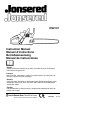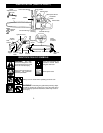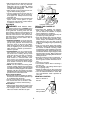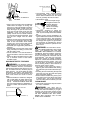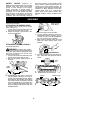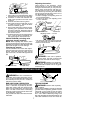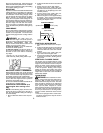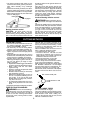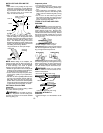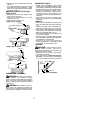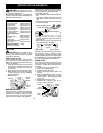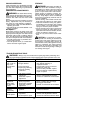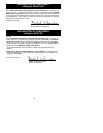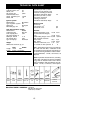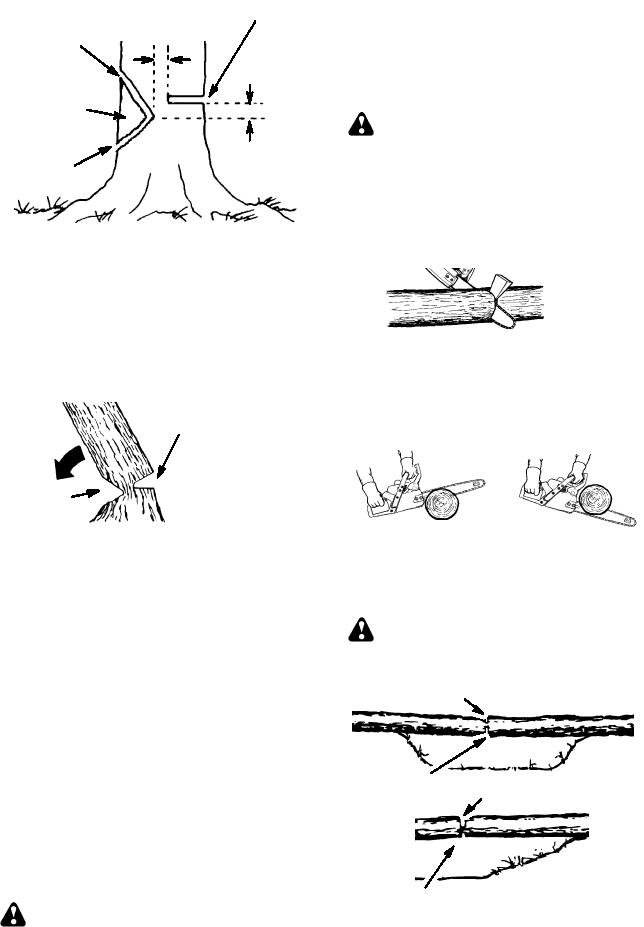
10
NOTCH CUT AND FELLING THE
TREE
S
Make notch cut by cutting the top of the
notch first. Cut through
1/3
of the diameter
of thetree. Next complete thenotch bycut-
ting the bottom of the notch. See illustra-
tion. Once the notch is cut remove the
notch of wood from the tree.
Notch
First cut
Second cut
Final cut here. 5 cm abov
e
center of notch.
5cm
5cm
S
After r em oving the wood from t he notch,
make the felling cut on the opposite side of
the notch.Thisisdone bymaking a cutabout
two i nches higher t han the center of the
notch. This will leave enough uncut wood
betw e e n the felling cut and the notch to form
a hinge. This hinge will help prevent the tree
from falling in the wr on g direc tio n.
Opening
of felling
cut
Closing of
notch
Hinge holds tree on stump and helps
control fall
NOTE
:
Before felling cut is complete, use
wedges to open the cut when necessary to
control the direction of fall. To avoid kickback
or chain damage, use wood or plastic
wedges, but never steel or iron wedges.
S
Be alert to s igns that the tree is ready to fall:
crack ing s ounds, w idening of the felling cut,
or m ovement in the upper branches.
S
As tree starts to fall, stop saw, put it down,
and get away quickly on your planned re-
treat path.
S
DO NO T cut dow n a partially fallen tree with
your saw. Be extremely cautious with par-
tially f allen trees that may be poorly sup-
ported. When a tree doesn’t fall com pletely,
set the saw aside and pull down the tree w ith
a cable w inch, block and tackle, or tractor.
CUTTING A FALLEN TREE
(BUCKING)
Bucking is the term used for cutting a fallen
tree to the desired log length.
WARNING
:
Do not stand on the log
being cut. Any portion can roll causing loss
of footing and control. Do not stand downhill
of the log being cut.
Important points
S
Cut only one log at a time.
S
Cut shattered wood very carefully; sharp
pieces of wood could be flung toward oper-
ator.
S
Use a sawhorse to cut small logs. Never
allow another person to hold the log while
cutting and never hold the log with your leg
or foot.
S
Do not cut in an area where logs, limbs,
and roots are tangled. Drag the logs into a
clear area before cutting by pulling out ex-
posed and cleared logs first.
TYPES OF CUTTING USED FOR
BUCKING
WARNING
:
If saw becomes pinched
or hung in a log, don’t try to force it out. You
can lose control of the saw resulting in injury
and/or damage to the saw. Stop the saw,
drive a wedge of plastic or wood into the cut
until the saw can be removed easily. Restart
the saw and carefully reenter the cut. Do not
attempt torestart your saw whenit ispinched
or hung in a log.
Turn saw
OFF
and use a plastic or
wooden wedge to force cut open.
Overcutting
begins on the top side of the log
with the saw against the log. When overcut-
ting use light downward pressure.
Overcutting
Undercutting
Undercutting
involves cutting on the under-
side of the log with top of saw against the log.
When undercutting use light upward pres-
sure. Hold saw firmly and maintain control.
The saw will tend to push back toward you.
WARNING
:
Never turn saw upside
down to undercut. The saw cannot be con-
trolled in this position.
Second cut
First cut on pressure side of log
First cut on pressure side of log
Second cut
BUCKING WITHOUT A
SUPPORT
S
Overcut through
1/3
of the dia meter of the
log.



